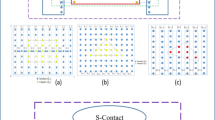Abstract
Significant regions of the depletion layer of a field effect device may contain only hundreds of dopant atoms. The randomness of the distribution of impurity atoms means that the average doping in the depletion layer varies from place to place in the plane of the surface. The cube approximation introduced by Shockley is adopted and used to divide the channel region of an FET into cubes whose edge is equal to the thickness of the depletion layer. The probability distribution of the threshold voltages of the cubes can then be calculated by using the Poisson distribution of impurity numbers. The conductivity of the array of cubes is treated by a modification of percolation theory. The arrays of importance in the theory of the FET are not very large, containing only tens or hundreds of elements, and the differences between nominally identical arrays is of interest to the average behavior of a large system. Random number experiments are used to develop a quantitative description of the probability of conductivity thresholds in the two-dimensional site problem with a finite number of elements. The finite percolation theory is combined with the cube threshold probability distribution to yield the probability distribution of threshold voltages of a field effect transistor in equilibrium.
Similar content being viewed by others
References
E.H.Nicollian, A.Goetzberger: Bell System Tech. J.46, 1055 (1967)
J.R.Brews: J. Appl. Phys.43, 2306 (1972);46, 2181 (1975)
R.Landauer: J. Appl. Phys.23, 779 (1952) and unpublished work
C.Herring: J. Appl. Phys.31, 1939 (1960)
P.Dean, N.F.Bird: Proc. Cambridge Phil. Soc.63, 477 (1967)
Scott Kirkpatrick: Phys. Rev. Lett.27, 1722 (1971); Rev. Mod. Phys.45, 574 (1973)
W.Shockley: Solid-State Electron.2, 35 (1961)
B.Hoeneisen, C.A.Mead: Solid-State Electron.15, 819 (1972)
S.M.Sze:Physics of Semiconductor Devices (Wiley-Interscience, New York 1969)
B.J.Last, D.J.Thouless: Phys. Rev. Letters27, 1719 (1971)
A.N.Broers, R.H.Dennard: InSemiconductor Silicon 1973, ed. by H.R.Huff and R.R.Burgess (The Electrochemical Society, Princeton 1973), pp. 830–841
S.R.Broadbent, J.M.Hammersley: Proc. Cambridge Phil. Soc.53, 629 (1957)
M.F.Sykes, J.W.Essam: J. Math. Phys.5, 117 (1964)
Author information
Authors and Affiliations
Rights and permissions
About this article
Cite this article
Keyes, R.W. The effect of randomness in the distribution of impurity atoms on FET thresholds. Appl. Phys. 8, 251–259 (1975). https://doi.org/10.1007/BF00896619
Received:
Accepted:
Issue Date:
DOI: https://doi.org/10.1007/BF00896619



